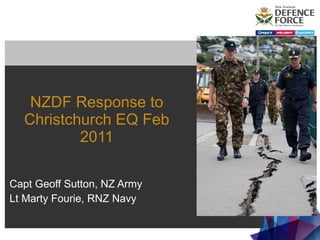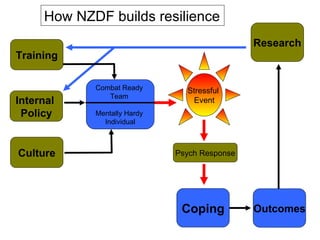G Sutton, NZDF response to Christchurch eq feb 2011
- 1. NZDF Response to Christchurch EQ Feb 2011 Capt Geoff Sutton, NZ Army Lt Marty Fourie, RNZ Navy
- 2. Overview The NZDF Resiliency Framework NZDF Involvement Psych Response to Chch EQ 2 Reactions of Our People NumbersŌĆ” Lessons Learnt
- 3. Training Internal Policy Culture Coping Research Outcomes Psych Response Combat Ready Team Mentally Hardy Individual How NZDF builds resilience Stressful Event
- 4. NZDF Involvement Op Awhina activated 3 ships; 1800 personnel involved Navy, Army, AF e.g. Cordon, body recovery (USAR), DVI, demolition, engineers, environmental health, catering, labour tasks etc NZDF Psychologists
- 5. Psych Response Aim reduce adverse effects of potential stressful events through education, normalising reactions, and identifying high risk personnel. What did we do? Initial surge of 3 psychŌĆÖs (2 local + Linton psych) to Burnham; rotation policy Personal perceptions Initial actions: identify need (e.g. high risk), created resources, implemented plan (incl screening), data management requirements.
- 6. Reactions of our people Lyttleton Cordon story: frustrations- engineers, boredom, fatigue (e.g. on cordon for 2 months) The birthdayŌĆ” Positive stuff- ability to get involved, satisfaction and rewarded, felt good about helping (e.g. engineers)
- 7. Figures 1800 personnel involved ~500 pers briefed 56 identified as high risk CISM Screened 11 required further support 6 Clinical referrals
- 8. Lessons Learnt Responsive capability Development of own resources Opportunity for learning and growth Supervision/ care for the carer? Cultural considerations








